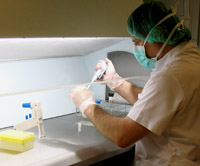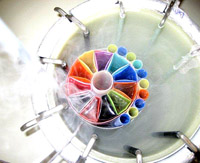Artificial insemination

What is intrauterine insemination?
Intrauterine or artificial insemination (IUI) is an assisted reproduction technique that involves depositing selected sperm in the womb, timed to coincide with ovulation, with the aim of reducing the distance they have to travel to meet the egg in the fallopian tubes. Sperm may be from the partner (Artificial Insemination by Partner (AIP)) or from a donor (Artificial Insemination by Donor (AID)).
What are the chances of success with this treatment?
 The success rate in AIP is about 20% per cycle, while in AID it is around 25% per treatment cycle.
The success rate in AIP is about 20% per cycle, while in AID it is around 25% per treatment cycle.
Bear in mind that the success of insemination depends on two factors: the age of the woman and the quality of the semen.
If pregnancy is not achieved after three cycles of insemination, we may suggest you consider more complex techniques such as In Vitro Fertilisation (IVF).
The insemination cycle consists of three stages:
Stimulation of ovulation
The aim of stimulating ovulation is to ensure the proper ovulation of a follicle in the ovary and to control your cycle to make it easier to synchronize ovulation and insemination. This stage lasts 7 to 14 days.
Preparation of the semen in the laboratory
On the day of insemination, the male provides a semen sample which is prepared in the laboratory in order to select the best sperm.
In the case of using donor sperm, the selected sample is simply thawed and prepared as a fresh sample.
Insemination
For the insemination itself, performed in the clinic, the selected sample is injected into the womb through a fine tube. It is a simple and painless procedure and does not therefore require an anaesthetic.
The administration of 1 egg is then indicated for the patient after insemination. This treatment is maintained until the patient has a pregnancy test, either on a blood sample at 14 days or a urine sample at 17 days.
Is insemination suitable for me?
The indications are different for the AIP and the AID.
Artificial Insemination by Partner (AIP) is indicated when:
- The semen quality is slightly below normal (mild male factor)
- The woman does not ovulate properly (ovulatory factor)
Artificial Insemination by Donor (AID) is recommended when:
- The semen quality is low or very low (severe male factor)
- The male is a carrier of hereditary diseases
- The woman has no male partner
The prerequisite for both types of insemination is that women have patent fallopian tubes to allow the sperm to meet the egg.
What are the risks for the patient?
The main risks of insemination are:
- Multiple pregnancy, as stimulating the ovaries causes more than one follicle to grow. 88% are singleton pregnancies, 11% are twin pregnancies and the risk of triplets is very low.
- Ectopic pregnancy occurs when the embryo implants outside the womb, usually in the fallopian tubes. The incidence is 1.7%.
- Ovarian hyperstimulation syndrome is caused by an excessive ovarian response to the medication, large follicle growth, and enlargement of the ovaries. The incidence is very low at less than 0.1% (according to the 2010 Spanish Society of Fertility registry).
Is it possible to avoid the risk of multiple pregnancies?
The risk of multiple pregnancies can be minimised with careful control of the growth of follicles in the ovary.



















